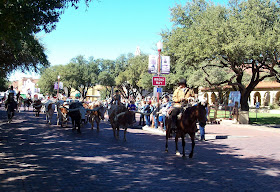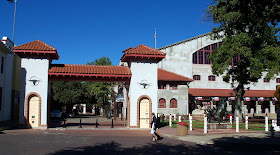During World War I, the Fort Worth Stockyards was largest horse and mule market in the world. Buyers came from around the world. During World War II, the Stockyards process 5,277,496 head of livestock. 1944 was the peak year of the entire operation but by 1969, sales were down to 1,045,158 head. The all time low hit in 1986 with sales of only 57,181 head. There were many reasons for the downturn but one big one was the huge trucking industry with lower costs than the railroad market. By 1962 Armour closed followed by Swift in 1971. The North Fort Worth Historical Society stepped in around 1976 and a museum was born. Efforts paid off to get the entire area declared an Historical District.
Today the Fort Worth Stock Yards are an Historical District as well as an entertainment center and are the one of the most popular tourist attractions in the state.
You can still see a cattle drive every day.
In case you wondered, this is how a cattle drive is set up. It is an orchestrated event rather than just cattle moseying along willy-nilly.
Part of the long horn herd.
Check out the horns on that lead steer.
Get along little dogies!
And then, of course, some of our group had to have a picture on a real live Texas long horn.
The big guy shook his head as Kim was hanging on to his horn.
The stock exchange building. Lots of money passed through here.
You have to wonder what some of these "Sister Cities" have in common with Fort Worth.
The Stockyards handled hogs and sheep in addition to cattle.
Now the big buildings have a whole new life housing shops and restaurants.
Gloria drove 2142 miles to get to the GTG and it was worth it.
This was reported to be a fantastic store to visit. Smelled like heaven according to Gloria.
This trough was clearly marked for cattle and horses only, no swimming allowed.
Carriage ride anyone?
We went to the Cowgirls Museum but there is one for Cowboys at the Stockyards.
I didn't get a chance to go in to the Stockyards Hotel but I was told that it is like an old fashioned saloon inside.
And the H3 Ranch is supposed to be one of the best steak houses around. We ate at Habanero's which was pretty good but really slow at getting the bill's out at the end.
We also made a stop at Billy Bob's, the world's largest honky-tonk. They charge to go in and look and there wasn't much going on during the daytime but it was interesting to look at the handprints from all the singers who have played there.
All in all, it was another really great day.

































You gals sure know how to whoop it up.
ReplyDeleteWe might have to check that area out next time we are in Texas....
ReplyDelete